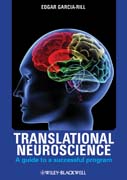
Translational research looks to take the latest innovations made in the laboratory setting to translate findings into effective and sustainable medical interventions and improved preventative measures. Funding support is increasinglytied to practical healthcare outcomes, with this trend likely only to increase in coming years, Translational Neuroscience: A Guide to a Successful Program, is a timely guide to developing research programs that bring translational advances to the forefront. Translational Neuroscience provides practical information from scientists with first-hand experience in developing a cutting-edge translational facility. The book opens with chapters that provide guidance to organizing a center for translational science. Chapters look at topics rangingfrom mentoring and career planning for clinician scientists to improving the design of core facilities and addressing infrastructure needs. The second halfof the book provides valuable case studies of translational neuroscience in action, with examples ranging from using to transcranial magnetic stimulation to studies on drug abuse and telemedicine applications. The final chapter looksto the future of basic science research, how academic health centers can be reorganized, and how future generations of translational neuroscientists can betrained. Translational Neuroscience provides a blueprint to developing an innovative and successful translational research program. Deans, department chairs, academic health center administrators, and researchers will find this guideuseful for drafting programs in translational research and avoiding costly pitfalls. While grounded in examples from basic neuroscience research, this bookwill be a useful tool to all scientists looking to develop centers of translational science across research disciplines. INDICE: Contributors xi Preface xiii Acknowledgments xv 1 A Brief History of Translational Neuroscience 1 Edgar Garcia-Rill Some recent history 1 Funding translational research 3 Lack of funding 4 Making NIH funding more equitableand efficient 6 How much funding is needed? 7 Medical research funding in Europe 10 References 13 2 Mentoring in Translational Neuroscience 15 Edgar Garcia-Rill T1 blocks 15 T2 blocks 20 References 27 3 Core Facilities for Translational Neuroscience 29 Edgar Garcia-Rill Designing translational neuroscience core facilities 31 Preattentional measurethe P50 potential 33 Attentional measurespsychomotor vigilance 35 Frontal lobe blood flow measures 36 References 42 4 Translational Studies Using TMS 43 Mark Mennemeier, Christine Sheffer, Abdallah Hayar, and Roger Buchanan Overview 43 Introduction 44 Development of a sham stimulation technique for humans 45 PET-guided TMS studies of tinnitus perception 46 TMS investigations of decision-making in tobacco addiction 50 TMS investigations in rodents 54 Conclusion 61 References 61 5 Translational Studies inDrug Abuse 67 Veronica Bisagno, William E. Fantegrossi, and Francisco J. Urbano Background and significance 67 Behavioral Core Facility 70 Voltage-sensitive dye imaging 75 Intravenous drug self-administration 75 References 79 6 Electrophysiology in Translational Neuroscience 83 Edgar Garcia-Rill In vivo and invitro animal models 83 Modafinil 84 Patch clamp recordings 85 Gamma band activity 86 Population responses 88 Preconscious awareness 89 Magnetoencephalography, the Cadillac of human electrophysiology 91 References 94 7 Translational Research on Spinal Cord Injury 97 Charlotte Yates and Kevin Garrison Electrophysiological approach: H-reflex frequency-dependent depression 98 Biomechanical approach: windup of the stretch reflex 100 Interventions: passive exercise 101Interventions: pharmacology (L-Dopa, Modafinil) 105 Conclusions 106 References 106 8 Translational Research in Neonatology 109 Richard Whit Hall Introduction 109 The need for neonatal research 110 The building blocks: basic research 110 Pups to babies and back again: T1 Research 111 No problem can be solved unless it is first identified 112 From the bedside to the community: T2 research113 The role of comparative effectiveness research 116 Barriers and rewards in translational research in neonatology 118 Opportunities for translational research in neonatology 119 Conclusion 119 References 120 9 Telemedicine in Translational Neuroscience 123 Amy Ballard and Richard Whit Hall History of telemedicine 124 Enabling access to care 125 Telemedicine Core Facility 126 Neonatalintensive care 129 Emergency departments 131 Conclusion 132 References 132 10Implications for the Future 135 Edgar Garcia-Rill Fragmented infrastructure 135 Incompatible databases 136 The benefits of translational research 138 The reshaping of basic science departments 139 References 142 Index 145 Color plates appear between pages 96 and 97.
- ISBN: 978-0-470-96071-4
- Editorial: John Wiley & Sons
- Encuadernacion: Cartoné
- Páginas: 168
- Fecha Publicación: 20/01/2012
- Nº Volúmenes: 1
- Idioma: Inglés
